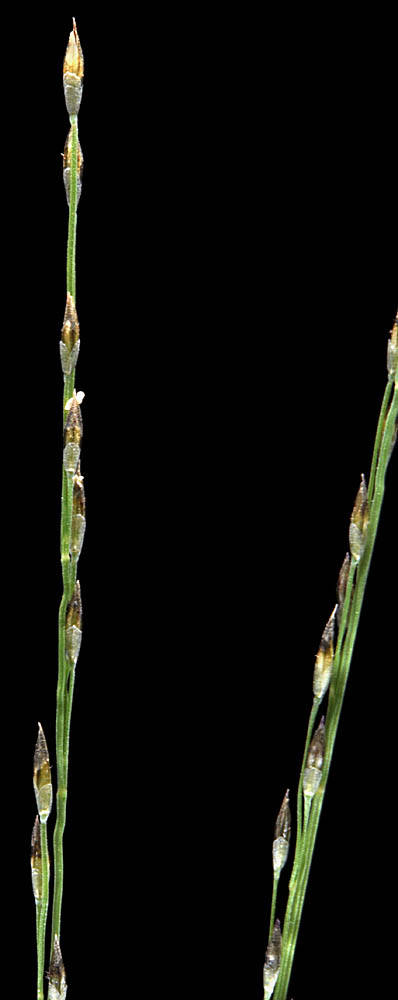
Plants annual but sometimes appearing perennial, (3)5–20(35) cm tall.
Culms often rooting at the lower nodes; not nodulose; internodes glabrous.
Leaves blades 1–4(6) cm × 0.6–1.6 mm, flat or involute; lower/outer surface smooth or minutely scabrous; upper/inner surface scabrous or pubescent.
Inflorescences spike-like, 1.6–6 × 0.2–0.5 cm, interrupted near the base, long-exserted from the upper leaf sheath; primary branches 0.9–1.2 cm ×over 0.1 mm, appressed at maturity or diverging 30(40)°; pedicels 1–3 mm, scabrous.
Spikelets 1.5–3.2 mm.
Glumes greenish gray, glabrous, 1-veined, rounded to subacute; lower glumes 0.6–1.4 mm; upper glumes 0.7–1.7 mm; tips rounded to subacute.
Lemmas (1.5)1.8–2.5(3.2)mm, lanceolate, dark greenish, appressed-pubescent on the margins and midveins, hairs shorter than 0.3 mm; tips minutely scabrous, acute to acuminate, awnless, sometimes with small points at the tip.
Anthers 0.5–1.2 mm, purplish.
2n=18.
Moist meadows, lake shores, stream banks. 100–2800m. BR, BW, Casc, ECas, Sisk. CA, ID, NV, WA; north to British Columbia, east to NE, south to Mexico. Native.
Muhlenbergia filiformis is a tiny, delicate annual usually about 5 cm tall, with a narrow, purplish inflorescence. It may form dense, turf-like stands. It often grows with similar M. richardsonis, a more robust, more or less rhizomatous perennial with nodulose stems and glabrous lemmas. This species gets its common name of “pull-up muhly” because cattle pull up clumps of the short plants but cannot manipulate them to eat them and thus drop the tufts on the meadows.
as described under Muhlenbergia filiformis
Plants annual (often appearing perennial), tufted. Culms (3)5-20(35) cm, erect or geniculate, often rooting at the lower nodes; internodes glabrous. Sheaths shorter or longer than the internodes, glabrous, smooth or scabridulous; ligules 1-3.5 mm, hyaline to membranous, rounded to acute; blades 1-4(6) cm long, 0.6-1.6 mm wide, flat or involute, smooth or scabridulous abaxially, scabrous or pubescent adaxially. Panicles 1.6-6 cm long, 0.2-0.5 cm wide, spikelike, interrupted near the base, long-exserted; primary branches 0.9-1.2 cm, closely appressed at maturity; pedicels 1-3 mm, scabrous. Spikelets 1.5-3.2 mm. Glumes greenish-gray, glabrous, 1-veined, rounded to subacute; lower glumes 0.6-1.4 mm; upper glumes 0.7-1.7 mm; lemmas (1.5)1.8-2.5(3.2) mm, lanceolate, dark greenish, appressed-pubescent on the margins and midveins, hairs shorter than 0.3 mm, apices scabridulous, acute to acuminate, unawned, sometimes mucronate, mucros shorter than 1 mm; paleas 1.6-2.6(3.1) mm, lanceolate, scabridulous distally; anthers 0.5-1.2 mm, purplish. Caryopses 0.9-1.5 mm, fusiform, reddish-brown. 2n = 18.
Muhlenbergia filiformis grows in open, moist meadows, on gravelly lake shores, along stream banks, and in moist humus near thermal springs, at elevations of 1060-3050 m. It is usually associated with yellow pine forests, but also grows in many other plant communities. Its range extends into northern Mexico. Muhlenbergia filiformis resembles M. richardsonis, but differs in having glabrous internodes and subacute apices. Large, robust specimens have been referred to M. simplex Scribn. or M. filiformis var. fortis E.H. Kelso but, until there is more evidence to the contrary, it seems best to treat such plants as representing an extreme of the variation within M. filiformis.